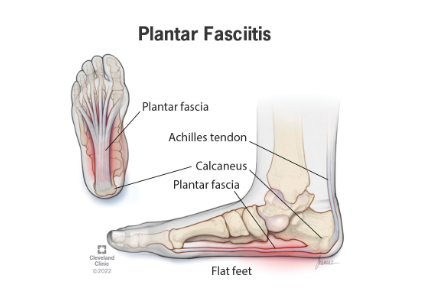By: Geraldus Sigap
Plantar fasciitis is a common condition that affects the bottom of the foot, specifically the area between the heel and the arch. It can cause sharp, stabbing pain, especially when taking the first steps in the morning or after sitting for a long period of time. This pain is usually located near the heel and can make walking or standing for long periods difficult. While plantar fasciitis is common, many people do not fully understand what causes it, how to treat it, and what steps can be taken to prevent it from recurring. In this article, we will explore the causes, symptoms, and treatment options for plantar fasciitis.

Figure 1. Plantar Fasciitis
There are several factors that can contribute to the development of plantar fasciitis. One of the main causes is overuse or excessive strain on the plantar fascia. This often occurs in athletes who participate in sports that involve a lot of running or jumping. In these cases, the repetitive motion can cause small tears in the plantar fascia, leading to inflammation and pain.
In addition to athletic activity, certain risk factors can increase the likelihood of developing plantar fasciitis. These include:
- Foot Mechanics: People with flat feet, high arches, or an abnormal walking pattern are more likely to develop plantar fasciitis. These conditions place additional stress on the plantar fascia, leading to inflammation.
- Age: Plantar fasciitis is more common in individuals between the ages of 40 and 60, although it can affect people of any age.
- Obesity: Carrying extra weight puts added pressure on the plantar fascia, making it more susceptible to injury.
- Occupations: Jobs that require long hours of standing or walking on hard surfaces, such as factory work or teaching, can lead to plantar fasciitis.
The most common symptom of plantar fasciitis is sharp pain in the heel, especially when taking the first steps in the morning or after periods of inactivity. The pain may decrease after walking for a few minutes but can return after prolonged standing or walking. Other symptoms include:
- Tenderness along the arch of the foot.
- Stiffness in the heel or arch, particularly in the morning.
- Swelling or inflammation in the heel area.
It is important to note that the pain is often worse after rest, as the plantar fascia tightens while you are not using it. Once you begin moving again, the tissue stretches out, which can cause significant discomfort.
If you suspect that you have plantar fasciitis, it is important to seek a medical evaluation. A doctor, particularly an orthopedic specialist, can diagnose the condition through a physical examination and by discussing your symptoms. They may press on different areas of your foot to locate the source of the pain and assess how your foot moves during walking or standing.
In some cases, imaging tests such as X-rays or an MRI may be ordered to rule out other conditions, such as stress fractures or heel spurs, which can also cause similar symptoms. However, these tests are usually not necessary for diagnosing plantar fasciitis.

Figure 2. X-ray of plantar fasciitis
Fortunately, there are several effective treatments for plantar fasciitis that can help relieve pain and promote healing. The goal of treatment is to reduce inflammation, stretch and strengthen the plantar fascia, and prevent further injury. Treatment options include:
1. Rest and Activity Modification
One of the first steps in treating plantar fasciitis is to reduce activities that place excessive stress on the foot, particularly running or jumping. Resting the foot allows the inflammation to subside and gives the tissue time to heal.
2. Stretching and Strengthening Exercises
Regular stretching of the plantar fascia and Achilles tendon can help relieve pain and improve flexibility. Your doctor or physical therapist may recommend exercises that stretch the calf muscles and the arch of the foot. Strengthening the muscles in your lower leg and foot can also help support the plantar fascia and reduce strain.
3. Footwear Modifications
Wearing shoes with good arch support and cushioning can significantly reduce pressure on the plantar fascia. Orthotic inserts, which provide additional support for the arch, can be especially helpful for individuals with flat feet or high arches. Avoiding walking barefoot on hard surfaces is also important.
4. Icing and Anti-Inflammatory Medications
Applying ice to the affected area for 15-20 minutes several times a day can help reduce inflammation and numb the pain. Over-the-counter anti-inflammatory medications, such as ibuprofen or naproxen, can also be effective in managing pain and reducing swelling.
5. Night Splints
Night splints are devices worn while sleeping that hold the foot in a slightly flexed position, keeping the plantar fascia stretched overnight. This can help reduce morning pain and stiffness.
6. Corticosteroid Injections
For severe cases of plantar fasciitis that do not respond to conservative treatments, corticosteroid injections may be recommended. These injections help reduce inflammation and provide temporary relief from pain. However, they are generally not a first-line treatment due to potential side effects.
7. Extracorporeal Shockwave Therapy (ESWT)
ESWT is a non-invasive treatment that uses sound waves to stimulate healing in the plantar fascia. It is typically used for individuals who have not responded to other treatments and is considered a safe and effective option.
8. Surgery
In rare cases where conservative treatments fail to provide relief, surgery may be considered. Surgical options include releasing part of the plantar fascia to relieve tension or removing a heel spur if one is present. However, surgery is usually only recommended after all other treatment options have been exhausted.
Once you have recovered from plantar fasciitis, it is important to take steps to prevent it from returning. Some tips for prevention include:
- Wearing Supportive Shoes: Choose shoes with proper arch support and cushioning, especially if you spend long periods on your feet.
- Maintaining a Healthy Weight: Losing weight can reduce pressure on the plantar fascia and lower your risk of developing the condition.
- Stretching Regularly: Stretching your calves, Achilles tendon, and the bottom of your foot can help keep the plantar fascia flexible and reduce the risk of injury.
- Gradually Increasing Activity: If you are starting a new exercise routine, gradually increase the intensity and duration of your workouts to avoid overuse injuries.
At RS Abdi Waluyo, our team of orthopedic specialists is experienced in diagnosing and treating conditions like plantar fasciitis. Whether you are dealing with heel pain, difficulty walking, or other foot-related issues, our orthopedic department is equipped with the latest technology and expertise to provide you with personalized care.
Resources
- Plantar Fasciitis: Symptoms, Causes & Treatment Options [Homepage on the Internet]. Clevel. Clin. [cited 2024 Oct 1];Available from: https://my.clevelandclinic.org/health/diseases/14709-plantar-fasciitis
- webmasterz. Plantar Fasciitis – A New Step Foot and Ankle Clinic | Podiatrist | Colorado Springs [Homepage on the Internet]. New Step Foot Ankle Clin. [cited 2024 Oct 1];Available from: https://anewstepfoot.com/podiatry-services/plantar-fasciitis/
- Plantar Fasciitis – StatPearls – NCBI Bookshelf [Homepage on the Internet]. [cited 2024 Oct 1];Available from: https://www.ncbi.nlm.nih.gov/books/NBK431073/
